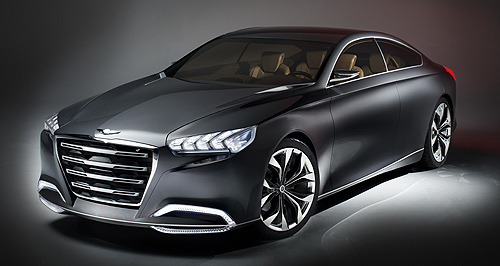Future models - Hyundai - GenesisDetroit show: Hyundai previews next GenesisAll-aw: The new Genesis sedan, previewed by the HCD-14 concept, will debut the new HTRAC system. HCD-14 Genesis concept showcases Hyundai’s luxury direction and future technologies15 Jan 2013 HYUNDAI previewed its cutting-edge future technologies and a classy new design direction at this week’s Detroit motor show with the HCD-14 Genesis concept. The concept points to the design of Hyundai’s next-generation Genesis luxury sedan, which will debut at Detroit in a year’s time and has a chance of eventually going on sale in Australia as it will be engineered for right-hand drive. Hyundai Australia public relations general manager Bill Thomas told GoAuto the local operation is looking at the business case for importing the rear-wheel-drive sedan. “We are considering the four-door (Genesis) but are not in a position to confirm that yet because we have to look at it in some detail,” he said. Based on its lack of luxury brand image, Hyundai would have to significantly undercut similar-sized rivals from the established premium brands in Australia to stand a chance of selling the Genesis here. In the United States, the Genesis line-up starts at $US34,200 ($A32,390) with a 3.8-litre V6 engine, topping out at $US46,800 for the 5.0-litre V8. For comparison, the similar-sized Lexus GS starts at $US47,250 with the 3.5-litre V6 ($A89,400 in Australia). With Hyundai’s most expensive model in Australia being the top-spec Santa Fe at $49,990 plus on-road costs, Hyundai Australia is looking at a significant step up in price for the Genesis. Further complicating things, being a premium niche model with unique drivetrain, the Genesis would probably have to be sold through a limited number of specialist dealerships, as Holden does with the Volt range-extender EV. In the US, Hyundai has quickly gone from a 1.4 per cent share of the premium vehicle market in 2008 to 9.0 per cent in 2012, and the Genesis has recorded some of the segment’s strongest resale values. Hyundai Motor America president and CEO John Kracik said the Genesis success story “paves the way for a new generation of rear-wheel-drive premium products”. “HCD-14 Genesis gives a hint of the design direction we’ll be taking, and an indication of the focus we’re placing on driving dynamics and technology,” he said. The HCD-14’s bluff nose with huge Chrysler-like chrome grille and LED lighting is juxtaposed by a sleek coupe-like roofline similar to that of the Audi A7, while the rear fascia is dominated by complex surfacing and tail-lights shaped to give the impression they are folded into the metalwork. Reflecting the shape and position of the front bumper-mounted LED daytime-running lights are cooling fins surrounding the oversized exhaust outlets in the rear bumper. In contrast with the relatively busy front and rear detailing are clean sides with no visible doorhandles, subtle scalloping and a single sharp crease running the length of the car. The rear doors are of the rear-hinged ‘suicide’ variety and open to reveal a lack of B-pillars and a sumptuous interior of leather and hand-crafted curved wooden features. Switchgear is conspicuous by its absence because Hyundai has used the concept to showcase three-dimensional “gesture recognition technology” that includes eye-tracking and touch-sensitive thumb controls, and is claimed to reduce driving distractions, backed up by a head-up instrument display projected onto the windscreen. The driver sits in an almost compartmentalised wraparound cockpit-style environment, where an optical recognition system authorises them and allows the engine to be started. Behind the steering wheel is a traditional instrument pack comprising a mixture of analogue dials and digital displays, with what Hyundai describes as “aviation-derived design cues”. Under the skin is an “ultra-rigid” chassis using high-tensile steel to provide a “vault-like platform for the rear-drive powertrain configuration”. Front and rear suspension is of a sophisticated five-link layout designed to reduce changes to wheel angle as they move up and down through the suspension’s travel, improving cornering grip. Hyundai says these chassis advancements enable its much-awarded Tau V8 engine – linked to the eight-speed automatic transmission it developed in-house – to be “fully exploited”. A replacement for the current LHD-only Genesis Coupe will also be built in RHD and is confirmed for Australia, but Mr Thomas said that car is still up to two years away. Shortly after Kia design boss Peter Schreyer was appointed president of the company following a successful reshaping of the brand by making some of the world’s most stylish cars, he has also been given responsibility to oversee design and styling for both Hyundai and Kia. It is unclear whether Mr Schreyer had any input to the HCD-14 project, but he will have some influence over the production Genesis replacement, its coupe namesake and future premium and mainstream Hyundais.  Read moreGenesis pricing
Motor industry news |
Click to shareHyundai modelsResearch Hyundai Genesis pricing
Motor industry news |











































Facebook Twitter Instagram